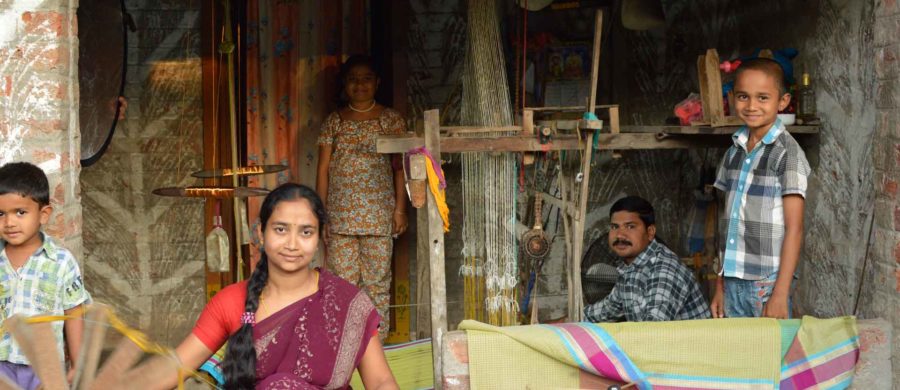
The Loom in the Weaving Marriage
Technology’s Stories v. 7, no. 2 – DOI: 10.15763/jou.ts.2019.06.13.04
“My marriage is made of gold,” says an elderly weaver from East Godavari. This is a defining statement about a life lived in handloom weaving.[1] It seemed like a non sequitur in a conversation about the effects of the 2008 economic downturn on handloom weaving—a contrast to words of despair and drudgery regarding the presence of the loom in the weavers’ life. Yet the state of people’s marriages came up regularly in discussions with weavers from the weaving villages of South India.[2] Young male weavers of Ponduru in Visakhapatnam district poked fun at their red-faced colleague in response to a query about delays in the production of a textile with a particularly complex structure, saying “It’s a new marriage!”.[3] Until the relationship between the weaving couple settled down, they implied, the loom would not produce its bounty. Another man, the son of a master-weaver named Gopichan, said: “My wife is a weaver, that is the secret of my success”.[4] Gopichand did not take up the trade until after marriage, and after his own family had left the business. He had married without the permission of his parents. His wife had taught him how to weave, and their joint work had shown Gopichand’s family that the marriage could produce economic value. The couple was initially in debt, but weaving together had helped them repay their loans and their faith in the loom.
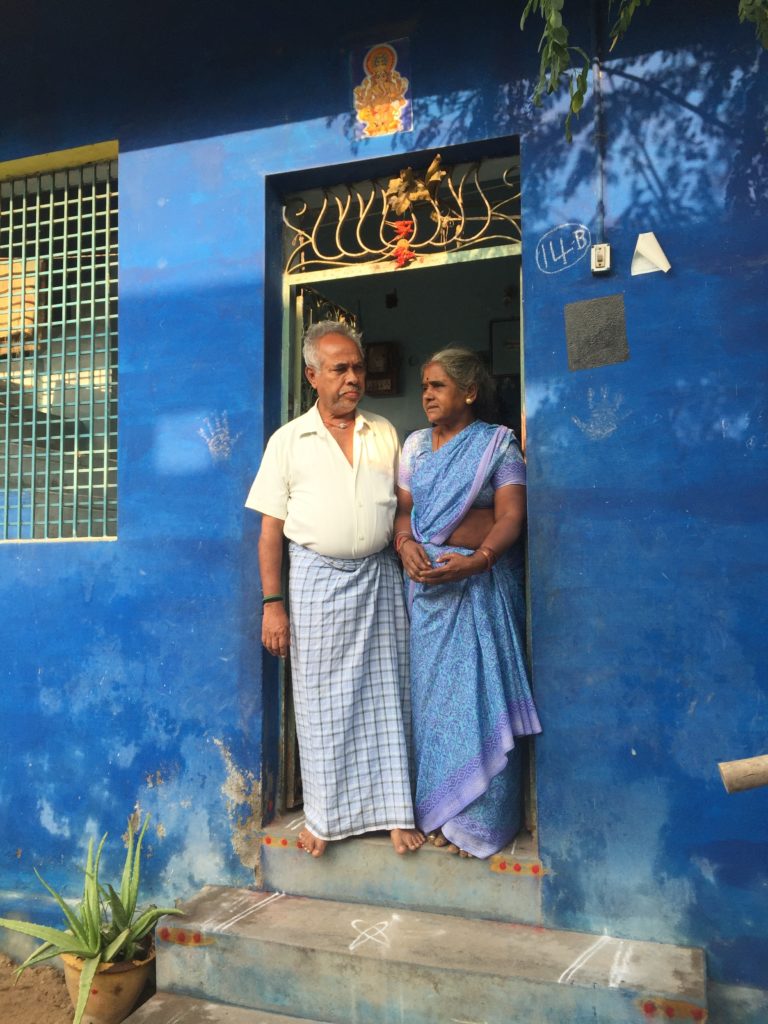
The practice of pairing man and woman, man and son, mother and daughter at the loom is common in contemporary weaving across India. There, as in pre-modern Europe and China, the household is the unit of production.[5] The artisanal weaving tradition in India, extant before the 13th century, survived shocks from the onslaught of industrialization in the 19th century. It supplied labor and capital to small-scale industry and resurged in the late 19th and 20th century.[6] Weaving’s prominence extends to the present. In the 2010 census, the weaving states across India reported a total of 4.33 million engaged in weaving as primary livelihood.[7]
The weaving communities explored in this essay are in the South Indian states. They include the Devangula, Padmasali, and Pattusali castes of East Godavari, Vijayanagaram, Prakasham (Andhra Pradesh), district of Kurnool (Telengana) and district of Kanchipuram (Tamil Nadu). I will set aside the complex issues of identity, labor, caste, social organization and gender to focus on how the institution of marriage emerged in conversations about the economic sustainability of household-based weaving.
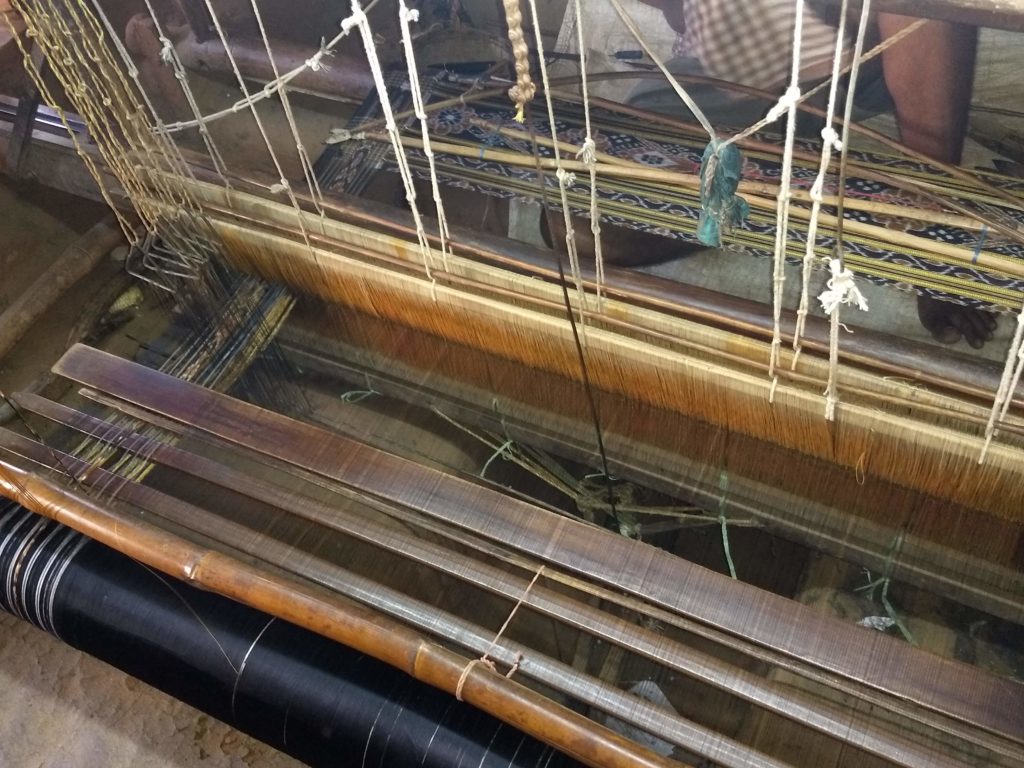
In the weaving villages of Andhra Pradesh, the traditional pit loom occupies pride of place in the very front of the house. It is neither completely inside nor outside. Weaving is a caste-based hereditary occupation. Unlike spinning, it is not a gender specific practice in these households, but its spatial seclusion inside the home partially masks women’s contribution to economic productivity.[8] The loom is not symbolic of domestic order, as in Ancient Greek narrative poetry.[9] The loom produces economic gains, affects gender relations and social realities, and influences shared life-worlds through its presence in the working marriage of weaver couples. The triad, of man, woman and loom, the so-called “marriage made of gold” is the focus of this story. This triad is productive, reproductive and constructive of shared worlds of households making a living from weaving.
The loom as productive technology
Weaver households become financially vulnerable during “karuvu” (droughts), which create financial hardship in the village and force migration to the city in search of livelihoods.[10] One of the weavers who experienced this, Maanem Vishwanath, left his home village Ponduru to seek work in the city but ultimately returned to work as a watchman at a local weavers’ co-operative. He speaks with quiet despair about the search for unskilled work in the city—washing bathrooms, cleaning chemical waste—and his decision to return. In reference to the skill that is embodied in his still-capable hands, he said, “Look at my hands, they are smooth…they are ground to this smoothness by the threads of the yarn that I have run them over, time and again while weaving; these hands are not made for manual labor, but I couldn’t make both ends meet here, I had to leave my village and home.”[11]
Vishwanath could not afford marriages for his daughters on his weaver’s income. Referring to young men who asked for gold in the dowry, he said a wife had become someone who could bring you a gold chain that you could “hang” around your neck, rather than someone who lived with you and shared your life. “Did you ever think of your wife as a burden that you had to be paid to carry?” he asked the other weavers in the room.[12] The pain and wisdom that accompanied his story made it difficult to miss the vulnerability that came with aging in a profession and moving to the city in search of unskilled work. He is grateful for the one good meal his wife receives at the hotel where she now works, revealing his sense of inadequacy for all the times his wife went hungry.
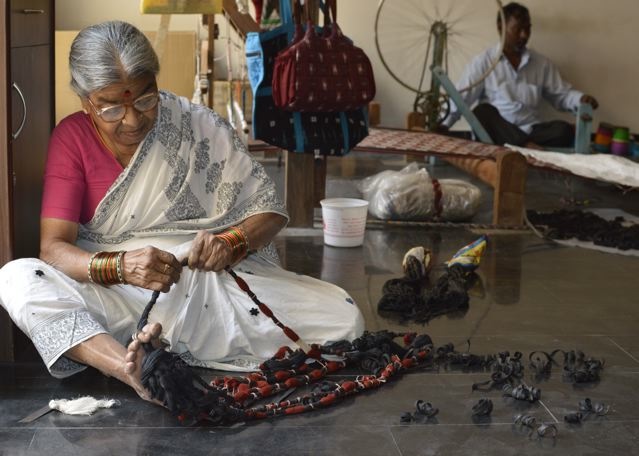
Not all stories end so badly. Boodida Apparao, another villager, said “I didn’t want her to be lonely, and there was enough work for both of us again.” This was why he came back to weaving with his wife Rashmi, from working in a far-off quarry.[13] When he emigrated to find work during bad times in the textile market, his wife kept working at the loom in the home. Since then, new opportunities in the market had made a place for him again, so he returned to companionable weaving with his partner in life, in the comfort of his own house.
Gold, in the form of jewellery accrued from surplus earnings within the marriage is considered “avasaram” —a need rather than luxury. In a meeting of weavers in the village of Ponduru, the women joked about their husbands’ inability to satisfy them with the gold that they “deserved,” and which they had earned as partners on the loom.[14] Gold is not a metaphor for desire but key to the performance of the woman’s financial role. Owning gold is simultaneously the wife’s area of expertise, the household’s capital, a hedge against bad times, and the legitimate assertion of the woman’s right to the family’s resources. Thus, master weaver Batta Pentarao’s wife, a woman too reticent to meet visiting guests or offer her name, was credited by the weavers in the group for deciding the time and place that the household would separate from the family-run business and set up on their own, pawning her gold to offset the financial risk.[15]
Knowledge travels with the loom and within the marriage. Yemigannur, a traditional center of weaving in the Deccan plateau, was once the home of more than 5000 weavers. In the ‘90s, the decline of a state-sponsored marketing agency, APCO, created a crisis that led to a significant downturn in the livelihoods of the weavers. Yet, by the mid-nineties, the weaving center was again humming with activity. An older weaver, speaking of the first weaver to set up the complex three shuttle loom that returned success to Yemigannur, wryly remarked:
none of us here would give him our daughter to marry. Drank too much, he did, that fellow. So he went to the nearby village of Gadwal [after which the technique is named] where they didn’t know him, and found a girl. When the father of that girl realized he was no-good, he tried to help his daughter by setting up looms here and encouraged her to teach her husband the technique. Otherwise the secret of their technique would never have been given out here![16]
The father’s training paid off, and the daughter and son-in-law, weaving together, began earning well; their marriage prospered. Within three years, more than 3000 weavers in the Yemigannur region were weaving the Gadwal saree, which enabled them to make a living despite the textile market downturn.
The loom as reproductive technology
The loom is not gendered in weaving marriages, but it enables specific kinds of gendered relations. Considering the loom as a reproductive technology highlights the ways that it shapes temporality as the life cycle of the weaver as a woman, as well as the life world of a woman as a producer. In a patriarchal society with a culture of work where women struggle for achievement and recognition—one that rewards those who put work above all else while continuing to evaluate them against traditional standards of marriage in homemaking and motherhood—the woman weaver provides new perspectives.[17] For example, food preparation during the hours of work is not the responsibility of a woman who weaves. Instead, she might rely on an older woman who sells “tiffins” (snacks) from a common kitchen nearby. Men and women might send out for food, usually treats for children or as hospitality to guests. The weaving-ancillary work of winding bobbins for shuttles, preparing warps and dressing the loom can accommodate the work of nurturing and care-giving of children and elderly dependants.[18]
Managing time at the loom is about sharing work between husband and wife, and flexibly responding to other pressing requirements outside of weaving. The work involved in daily-, annual- and life-cycles can be interrupted and resumed. Work may slow down when only one spouse is available, but the loom continues to be productive. Work is organised around annual festivals and the lunar calendar. Every new moon is a day off, and festivals coincide with farming cycles: planting, rain, harvesting. The coastal villages are vulnerable to flooding during cyclones, the pits the looms are set in fill up with water, and work comes to a standstill. It is the same if there is a drought; if the farmers starve, the whole village is in drought.
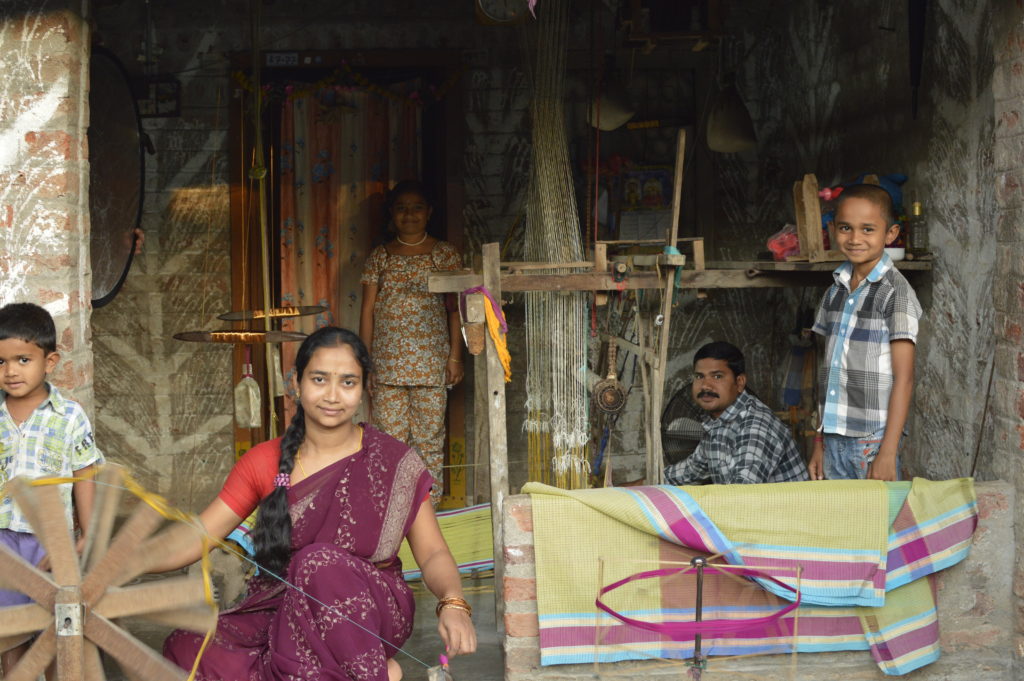
The cloth woven on the loom can be varied in type. Whether the man is the primary weaver (for instance, if the woman is in her child bearing years), or when the woman is the primary weaver (when times are bad and the husband migrates in search of work), the loom affords the couple different choices based on how they organize work around the loom. When both spouses weave together, the loom may generate even more creativity, depending on the skill and openness of the weavers to new opportunities in the market.[19]
Bright eyed and smiling, Sashi and Latha (two women weavers in their early thirties from Kanchipuram in Tamil Nadu) work in the Craft Education and Resource Centre in Kalakshetra in Chennai.[20] Latha is not literate but weaves on the complex jaala (brocade) loom with her husband, Harikrishna. She was sent out to work at the age of ten because her family did not own looms, but within four years she was weaving on her own. She remembers her teachers with affection, and she is proud of her skills. Hers was not an arranged marriage, . She and her husband worked next to each other in a weaving workshop, fell in love, and chose to marry. Recently, Harikrishna was working in a mechanic shop when they were invited to the Centre to learn the complex weaving techniques that the Centre demanded. They had “to relearn to weave the parrot motif,” he says, “I asked her if we should do it, she said ‘OK’.” Working together would improve their income, and was a reason to restart weaving, but Latha says “weaving together makes us one ‘anyonyam’”, meaning harmoniously one or of one mind.[21]
Sashi, who weaves with her husband Muthu, is more forthcoming. “I won’t work anywhere else, we only want a good name as good weavers.” She too chose to marry Muthu “yes, love marriage” she smiles. She learned weaving within her marriage: “I taught her in one week,” brags Muthu. Sashi adds “If we stay home without work, we will bicker, I like working with him, I never have to worry that he is somewhere out, and I am alone at home, waiting for him, I would find that difficult.”[22]
The construction of shared worlds
Weaving together is a physical immersion in work that produces a harmonious state of mind and a mutually respectful relationship. Weaving is embodied and material. The shuttle passes in hand from husband to wife and back in silence. Only the loom speaks. “This is our life,” said a middle-aged woman Thangamani with a smile, sitting at the loom alongside her husband, Velu.[23] In a society where custom decrees that husband and wife may be in physical proximity to each other only at religious ceremonies and rituals or in complete privacy, weaving together creates a sanctioned out-of-custom connection. When weaving together, the two bodies must be in synchrony with each other and with the loom; their physical harmony produces motifs of perfect proportions. Yet, even stored in the attic, when financial and familial responsibilities split up their working life and take them away from the loom, the loom maintains a continuity in the marriage. It allows the integration of the life worlds of the man and woman, yet also maintains their productive and reproductive roles intact.
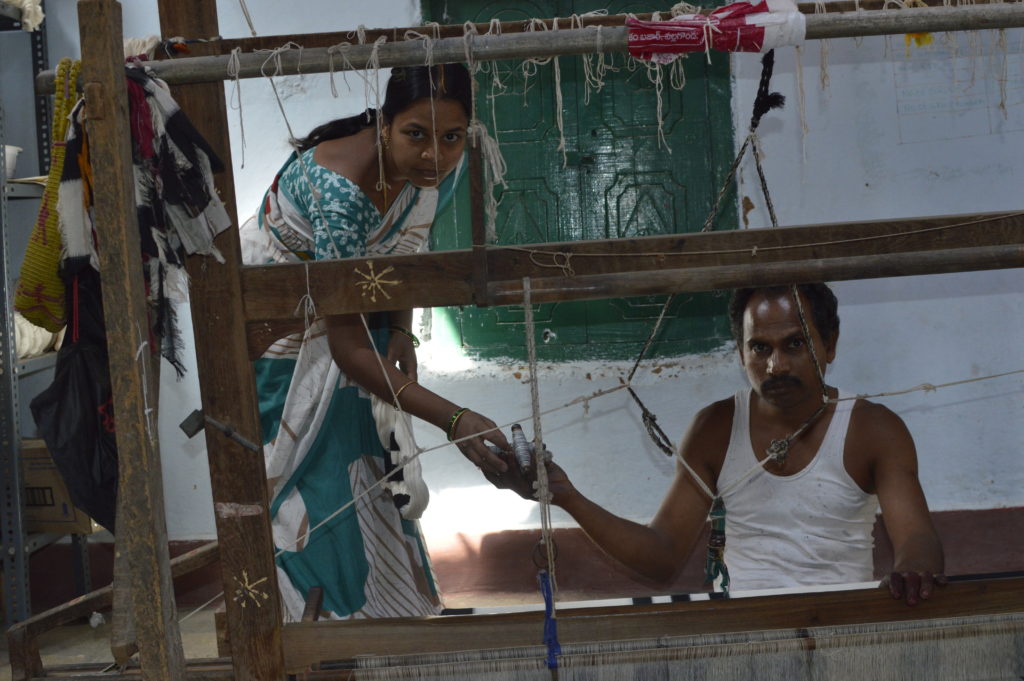
To weave is to analyse and code.[24] To weave is to imagine new possibilities, to make independent choices using computational skills.[25] More important, to weave is to recognise and afford women their own mental acuity and agility. The image of Penelope at her loom is not only an example of a woman patiently awaiting a husband’s return, but also of someone who is analysing and planning. The image highlights her agency and wiles in outwitting the brute strength of her male suitors. Yet, when a woman weaving is with her husband, the couple become anyonyam, which allows for a mutual projection of what will come to be on the loom and in their life.
Marriage is not constructed in its idealised perfection, but is crafted fresh everyday, accommodating possibilities for change as the world changes. Women weavers speak of financial decisions made together, of decisions to send daughters to school, of work and life kept in balance. This modern social reality coming out of a traditional way of working is a powerful counter to imagined traditions such as the representation of the opulent aesthetic of the British Raj as authentic Indian heritage. A perverse social reality appears in fantastic visual spectacles as when a princess, dressed in elaborately crafted costume, commits sati (ritual self-immolation) in the face of unwelcome advances from a rogue emperor in the 21st century Bollywood retelling of a story of Rani Padmini from medieval India.[26]
Instead, the quiet autonomy of young women weavers, and their pride in their work and their partnerships challenges stereotypes of the traditional marriage as an inherently unequal one. But what we discover in entering the social world of the weaver is that it is the hand loom, present materially in the young weavers’ relationship, that equally weaves the golden marriage, one beautiful saree to the next.
Annapurna Mamidipudi is a visiting research fellow at the Max Planck Institute for the History of Science in Berlin. Her research investigates the ways craftspeople in South India use and make knowledge to sustain their livelihoods in contemporary society. Working at the intersection of craft practice and research, she organizes hybrid spaces for exchanges between different ways of knowing to take place, between craftspeople, scholars, activists and policy makers.
Bibliography
Apparao, Boodida. Boodida Apparao, Weaver age 49, Ponduru (Andhra Pradesh). Interview by Annnapurna Mamidipudi. Transcription, February 25, 2010.
Bagchi, Amiya Kumar. “De‐Industrialization in India in the Nineteenth Century: Some Theoretical Implications.” The Journal of Development Studies 12, no. 2 (1976): 135–64.
Barber, Elizabeth Wayland. Women’s Work – the First 20.000 Years : Women, Cloth and Society in Early Times. New York, N.Y.; London: Norton, 1995.
Bhansali, Sanjay Leela. Padmaavat. Bhansali Productions, 2018.
Bray, Francesca. “Gender and Technology.” Annual Review of Anthropology 36 (2007): 37–53.
Clark, Susan H., and Valerie L. Schwiebert. “Penelope’s Loom: A Metaphor of Women’s Development at Midlife.” Journal of Humanistic Counseling, Education and Development 40, no. 2 (170 161AD): 2001.
Field Notes, Dastkar (Andhra Pradesh). Interview by Annnapurna Mamidipudi. Transcription, February 1998.
Field notes, Yemigannur Village, Dastkar Andhra. Interview by Annnapurna Mamidipudi. Transcription, September 1995.
Focus group discussion, Mandapeta (Andhra Pradesh). Interview by Annnapurna Mamidipudi, January 23, 2012.
Focus group discussion, Ponduru (Andhra Pradesh). Interview by Annnapurna Mamidipudi, February 25, 2010.
Gopichand. Gopichand, Weaver in Chirala (Andhra Pradesh), age 40. Interview by Annnapurna Mamidipudi. ???, February 28, 2010.
Harlizius-Klück, Ellen. “Weaving as Binary Art and the Algebra of Patterns.” TEXTILE 15, no. 2 (2017): 176–97.
Interview with weaver members at the “Daram” retail store, meeting organised by Dastkar Andhra in Hyderabad, South India, in 2010, 2nd October 2011. Transcription, October 2, 2011. http://www.dastkarandhra.org/.
Latha, and Harikrishna. Interview with Latha and Harikrishna, Chennai. Interview by Annnapurna Mamidipudi. Transcription, March 11, 2018.
Mamidipudi, Annnapurna, and Wiebe Bijker. “Innovation in Indian Handloom Weaving.” Technology and Culture 59, no. 3 (2018): 509–45.
Mamidipudi, Annnapurna, B. Syamasundari, and Wiebe Bijker. “Mobilising Discourses.” Economic and Political Weekly 47, no. 25 (2012): 41–51.
McLean, Alex, Ellen Harlizius-Klück, and Janis Jefferies. “Introduction: Weaving Codes, Coding Weaves.” TEXTILE 15, no. 2 (2017): 118–23.
Pantelia, Maria C. “Spinning and Weaving: Ideas of Domestic Order in Homer.” The American Journal of Philology 114, no. 4 (1993): 493–501.
Sashi, and Muthu. Sashi and Muthu, Chennai. Interview by Annnapurna Mamidipudi. Transcription, March 11, 2018.
Simmons, Colin. “’De-Industrialization.’ Industrialization and the Indian Economy, c. 1850–1947.” Modern Asian Studies 19, no. 3 (1985): 593–622.
Thangamani, and Velu. Thangamani and Velu, Kanchipuram. Interview by Annnapurna Mamidipudi, March 12, 2018.
“Third National Handloom Census of Weavers and Allied Workers.” National Council of Applied Economic Research, 2010. http://handlooms.nic.in/Writereaddata/Handloom%20report.pdf.
Vishwanath, Maanem. Maanem Vishwanath, Weaver age 55, Ponduru (Andhra Pradesh). Interview by Annnapurna Mamidipudi. Transcription, February 25, 2010.
[1] Interview with weaver members at the “Daram” retail store, meeting organised by Dastkar Andhra in Hyderabad, South India, in 2010, 2nd October 2011.
[2] From 1990-2014 I worked in several capacities at Dastkar Andhra, an NGO in South India supporting livelihoods of handloom weavers. Many of my conversations around sustainability in weaving are from that period. In 2010 I returned to the field as a researcher, and continued these conversations.
[3] Field Notes, Dastkar (Andhra Pradesh).
[4] Gopichand, Gopichand, Weaver in Chirala (Andhra Pradesh), age 40.
[5] Bray, “Gender and Technology”; Mamidipudi and Bijker, “Innovation in Indian Handloom Weaving”; Pantelia, “Spinning and Weaving: Ideas of Domestic Order in Homer.”
[6] Bagchi, “De‐Industrialization in India in the Nineteenth Century: Some Theoretical Implications”; Simmons, “’De-Industrialization.’ Industrialization and the Indian Economy, c. 1850–1947.”
[7] “Third National Handloom Census of Weavers and Allied Workers.”
[8] Bray, “Gender and Technology.”
[9] Pantelia, “Spinning and Weaving: Ideas of Domestic Order in Homer.”
[10] Mamidipudi, Syamasundari, and Bijker, “Mobilising Discourses.”
[11] Vishwanath, Maanem Vishwanath, Weaver age 55, Ponduru (Andhra Pradesh).
[12] Vishwanath.
[13] Apparao, Boodida Apparao, Weaver age 49, Ponduru (Andhra Pradesh).
[14] Focus group discussion, Ponduru (Andhra Pradesh).
[15] Focus group discussion, Mandapeta (Andhra Pradesh).
[16] Field notes, Yemigannur Village, Dastkar Andhra.
[17] Clark and Schwiebert, “Penelope’s Loom: A Metaphor of Women’s Development at Midlife.”
[18] Barber, Women’s Work.
[19] Mamidipudi and Bijker, “Innovation in Indian Handloom Weaving.”
[20] Sashi and Muthu, Sashi and Muthu, Chennai; Latha and Harikrishna, Interview with Latha and Harikrishna, Chennai.
[21] Latha and Harikrishna, Interview with Latha and Harikrishna, Chennai.
[22] Sashi and Muthu, Sashi and Muthu, Chennai.
[23] Thangamani and Velu, Thangamani and Velu, Kanchipuram.
[24] McLean, Harlizius-Klück, and Jefferies, “Introduction: Weaving Codes, Coding Weaves” See also the contribution here by Daniela K. Rosner and Shorey.
[25] Harlizius-Klück, “Weaving as Binary Art and the Algebra of Patterns.”
[26] Bhansali, Padmaavat.
